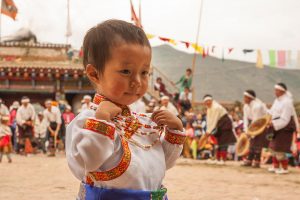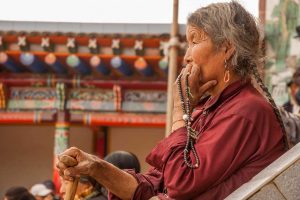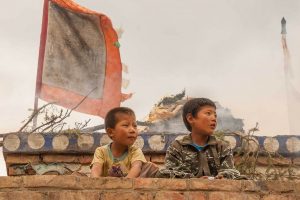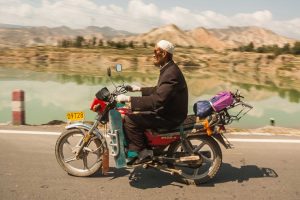
People of heights
Tibetans are a people of heights, with a territory that spreads over the Tibetan plateau, also covering the provinces of Yunnan, Sichuan, Gansu and Qinghai. It is there, where the land begins to rise, where inhabits this proud and hardened people.
To the southeast of Qinghai Province is Tongren County, Regong (Golden Valley) for Tibetans. In exchange for 30 Yuan and four hours, a shabby bus takes us there from Xining, the provincial capital. We traverse arid and mountainous landscapes where the first section of the Yellow River flows, and the waters still don’t carry the sediments that give it its name. The colours of the soil change: red, yellow, white and red again, a contrast against the bright turquoise waters. Along the river there are cultivations and villages of ethnic Muslims, mostly Salar and Hui; descendants of Arab mercenaries who arrived around 600 BC across the Silk Road.
Three hours have passed when we leave behind the Yellow River to enter the mountains. The road is dotted with landslides around which the cars have no choice but to reluctantly give way. We begin to glimpse the first signs of Tibetan culture. Always faithful to their gods, dwelling near them, sharing the heights. Stupas, votive flags swaying in the wind, huge murals in impossible places, some of them even carved. As if it was a review of the history of Tibetan art, the first drawings that we see are more primitive, simple and black, representing dancing figures making offerings of khadag, a customary Tibetan white silk fabric.
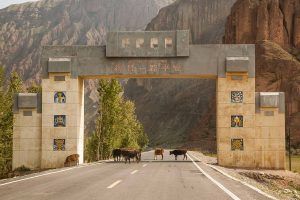
The Jiugu Valley
We have ascended to 2,500 meters, leaving behind the dusty road to enter a dream valley, formed around the river dGu-chu, Jiugu in Chinese. Crops of barley and wheat grow at the banks of the river, golden under the bright sun. There are many trees and villages with low adobe houses, Tibetan flags (tar-chog) waving in their courtyards. But the most outstanding are the monasteries, ostentatious and colourful next to the humble houses.
Almost two thousand years ago, during the Han Dynasty, the valley was a border between the Chinese and Tibetan empires, becoming a settlement area for Chinese central government troops. Even so the greatest influence in the valley remained Tibetan culture. The government combined Tibetan Buddhism and politics, with the monastery of Longwu at its epicentre.
In 710 AD, Tang Dynasty era, the valley was handed over to the Tibetan empire, as the result of peace negotiations between the two empires. Since then it has been a Tibetan settlement, assimilating the Mongolian Proto-Turks and the descendants of the Qiang ethnic group who had long inhabited the area. Even long after the fall of the Tibetan Empire the largest ethnic groups were descendants of Tibetan soldiers as well as settlers who came from the centre of Tibet, perhaps in search of a land where life would be less difficult.
Regong is also the most important centre of Tibetan art, with 700 years of history. Their thangkas (a Tibetan painting on cotton or silk) and sculptures are well known both in Southeast Asia and in Western countries.
Tibetans are a people zealous in their traditions, aware of the risks of their ethnic identity in a country like China, where 95% of the population belongs to the Han ethnic group. As a people who have historically combined religion with government, religious aspects permeate almost every aspect of their customs. This religious fear has perhaps survived better than in other cultures, given their close relationship with nature and the harshness of inhabiting environments as inhospitable as they are beautiful.
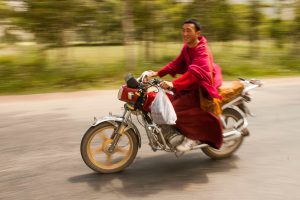
The religions of Tibetans: Popular, Lamaist and Bön Buddhism
The religion of Tibetan people is not limited to Tibetan Buddhism, but also holds important influences of Bön religion, hitherto little studied. Formerly the religion that spread throughout Siberia and Central Asia was animist. Bön was the Tibetan side of this religion. As it became entrenched in Tibetan culture, the first monasteries appeared, developing their own doctrine. But later, supported by the kings of the time, came the triumph of Buddhism. It was then that Bön became heresy and their adherents were forced to adopt elements of Buddhist religion to survive.
Tibetan Buddhism is the result of blending popular religion, Buddhism and Bön. Its rapid expansion was due to the intentional assimilation of popular religion. The only difference is that both Bön and Buddhist religions deal with affairs of the other world, such as karma and reincarnation, while popular religion only cares about worldly affairs.
Laru Festival (Glu-rol)
The Laru festival or Glu-rol is a specific communal rite of the Regong area. With magical-religious elements, it is based on the giving of offerings to the protective gods as well as communication with them through a medium or lhawa. This festival is held annually between the 15th and 25th of the sixth month of the Tibetan solar calendar, the period of the summer solstice called Glu-rol, hence the festival name. It usually lasts three days, but the gods can request more days through the medium. The function of this ritual is to seek prosperity and health for the villagers as well as the fertility of livestock and good harvests.
The area of Regong has several villages and this makes the festivals itinerant. The participants of each festival usually belong to the same clan or tribe, while members of neighbouring clans or tribes come to visit the festivals of others as a gesture of courtesy.
According to a legend, in times of the Tibetan Empire battles between Chinese and Tibetans were frequent in this border area and both sides suffered heavy losses. The peace treaty that ended the struggle was signed on the 22nd day of the sixth month, the Laru festival being a commemoration of this treaty.
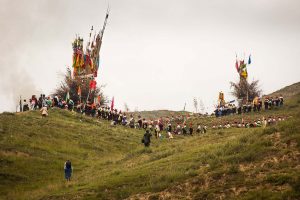
The mountain gods
In each of the villages of Regong there are sanctuaries (ndekheng) that shelter the statues of the three mountain gods: Moggul, Trazil and Nyenchin. Moggul is the oldest and most powerful. According to the legend, he comes from Khamse, the “Red Mountain”, hence the red colour of both his face and his horse. Trazil, a heroic god, helped the Tibetans to definitively defeat the Muslims in a battle. Nyenchin, the third god, although important to many Tibetans, is not present in the rituals of Regong, since according to tradition he doesn’t inhabit any of the mountains surrounding the valley. The mountain gods participate in the festival through the medium. When the lhawa is in trance, the god uses him as a means to speak to or punish people for their offenses.
The festival begins
On the first day of the festival, early in the morning, men and children in traditional dress go to the hill behind the temple of Moggul, where two levtsis are erected, a kind of altar dedicated to the mountain gods. From here rise poles with tar-chog, pieces of cloth with mantras blown by a wind that takes them to all corners, benefiting as many people as possible. At the foot of both altars a fire is kindled, on which offerings of flour and alcohol are poured.
There are two lhawa, an older one leading the column of men and a younger one standing next to the levtsis where they make the offerings. The older man is smoking while engaged in lively conversation with the men at his side. Meanwhile, the youngest man is in trance. His body jerks, heaving continuously, although his gaze is lucid and restless, quickly following the movements of those who give offerings.
Longtas, small coloured papers with the image of a winged horse, are thrown up into the sky, taking advantage of the ascension of the smoke to rise even more. The more they climb the more auspicious they are. After a short time the major lhawa begins to direct the column of men downhill towards the temple, ordered by age, the smaller ones closing the row. The descent is marked by the rhythm of a tambourine, interrupted only by some shout praising the gods that is enthusiastically seconded by the rest.
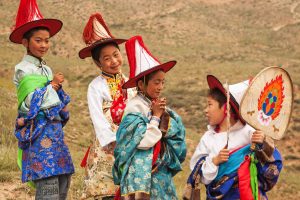
Entering the temple through the back door, we are surprised to see a man chopping a lamb with water boiling in two huge cauldrons behind him. Meanwhile at the front door the parade of men goes to the center of the courtyard. Following the orders that the young lhawa gives between spasms they begin a circular dance. They form a changing spiral that narrows, allowing the gradual entry of other participants. The first young women who will also dance arrive and go to the porch at the right side, where other women are with their children and grandchildren. The men’s dances are directed to the mountain gods, while the women’s dances are dedicated to the gods of water, also called klu. While for men there is no age limit, women can only participate until they are married.
The dances continue and the oldest lhawa starts dancing frantically, assisted by three young men that surround him to avoid him hitting anybody, which would be interpreted as a punishment from the gods. Besides him, the youngest lhawa scatters alcohol and seeds on the ground.
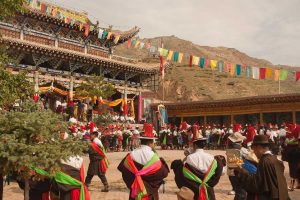
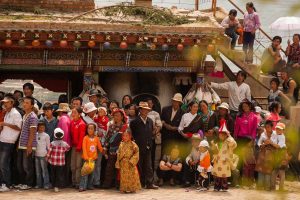


Women approach the steps that ascend to the temple carrying offerings of yogurt, seeds, alcohol and a kind of castle-shaped dough. When they reach the first step, the male members of their clan are summoned to pick up the presents, because if the women would deliver them directly their long manes would distract the gods, hindering the communication with the men.
Sitting in the shade under the khadag strung on the columns, the elders carefully observe the movements of the lhawa because they are the only ones who can interpret the gods. As the day goes on the volume of their voices, their laughter or the wobbling of some old man crossing the square (helped by a young family member) is a sign that they are giving a good account of the alcohol offerings. As they say: “The gods like to drink, but accompanied”.
Suddenly at a signal of the lhawa the dancing men leave the square to make way for the young women who will do the “dragon dance”. Although the age limit is 25 years it seems that none exceeds eighteen. This is because most of the village girls are in college and did not have time yet to return for the first day of festival, although they will do so for the following. The clothing of the girls is the traditional Tibetan robe with heavy turquoise and coral ornaments hanging from their hair that emulate the scales of the water deities they dance for. The girls move to the beat of a drum of softly metallic sound, looking down in submissive attitude. With both hands extended they hold the long sleeves so as to hide them, and make small and timid movements back and forth, mimicking the movement of waves. Like men they go in order of age, the oldest at the front holding a khadag and the smaller behind in less submissive attitude. Some are so young that it is amazing to see them duly following the line, although quite disoriented, searching for familiar faces among those who watch and laugh. After the dragon dance the men go out in small groups, taking turns dancing with and without tambourine, always under the direction of the young lhawa, who continues to make offerings, sometimes joining them in the dance.
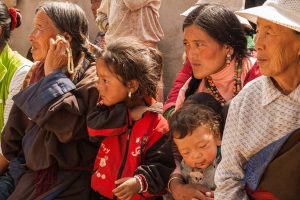


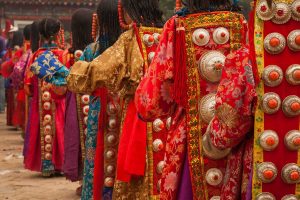
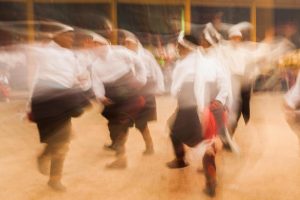
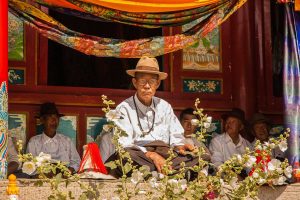
It’s been three hours since the beginning of the ritual, and the lhawa calls out for two boys dancing on orange stilts. One emulates a tiger and the other a snow leopard. The boys alternate their dance with different instruments, always assisted by other lads who prevent people from interfering.
After they leave everyone suddenly rises as sign of respect. An old lama accompanied by two young men makes his entrance into the courtyard. Everything seems to stop while he walks slowly towards the temple.
The presence of the lama is a purely political act, a courtesy, since he is not allowed to participate directly in the ritual. Once he disappears inside the temple the lhawa calls the daemons to dance: two barefoot boys wearing a mask, making genuine contortionist movements.
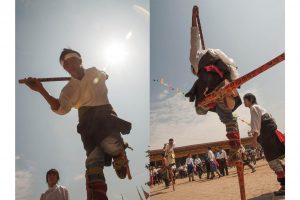

While the dances continue, the men begin to carry offerings to burn them on the altar that is on the entrance porch to the temple. At noon the whole set of participants comes out to dance in what seems the final touch of the morning dances. With the dance finished they all go to eat. The ritual will continue in the afternoon. The elders stay, always in surveillance, eating the delicious lamb stew prepared that morning, which they share with the few who still remain there, faithful to the ritual even though the activity has lessened. From the crowd, only the guardians are left to prevent the gods from feeling alone, but the dances do not cease. It is the moment for jokes, and a group of old men goes out and dance for the joy of the few present ones, so endearing are their awkward movements and their shining bald heads under the sun.
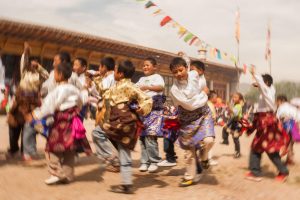
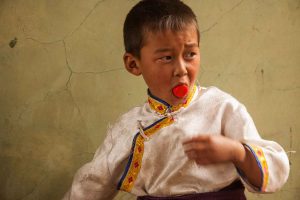
In the afternoon the crowd has increased; people from other villages have come to pay their respects. The dances continue like in the morning, in addition to the performance of a group of clowns, including several middle-aged men who had been drinking merrily on the porch.
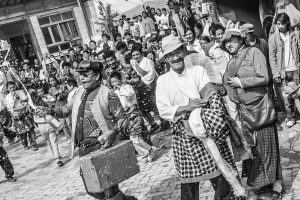

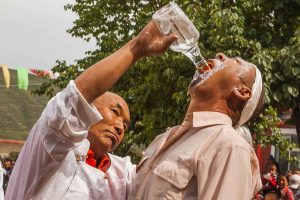
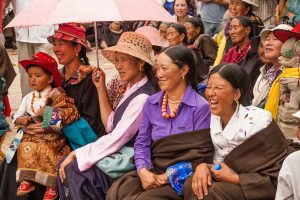
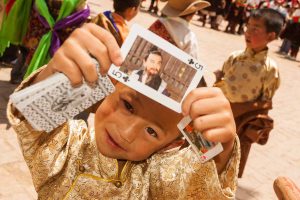
Blood offerings
The following days of the festival are a repetition of the first day with one exception: the second day dawns rainy and the presence of foreigners and the curious outside the ritual is practically nonexistent. Perhaps that is why men who wanted to make their blood offering take the chance to dance with knives. They strike their foreheads vehemently with the blades. It is auspicious for the man who makes the offering if he bleeds a lot. This practice was more common before when the liberalizing policies of Deng Xiaoping allowed the revival of religious traditions that had been oppressed during the early years of the Communist regime. However, Buddhism, which ultimately is the dominant religion of the Tibetan people, is against this manifestation. Its total disapproval has come to reduce the prevalence of this ritual considerably although it is still practiced occasionally, like this rainy morning in Regong.
For Tibetans these rituals are not part of religion but a tradition. A tradition that unites them, facilitating community cohesion and the restoration of ties as well as a way to reinforce, year after year, their proud ethnic identity.
And it is precisely this strong identity so little shared by other ethnic groups in China, that distinguishes it and makes it attractive and mysterious like few others.
